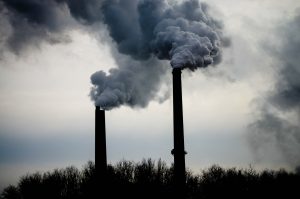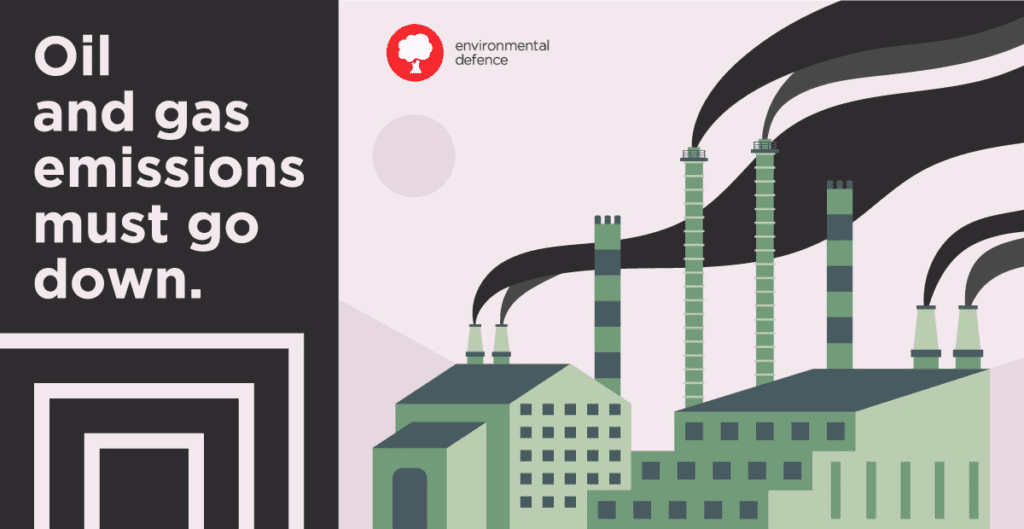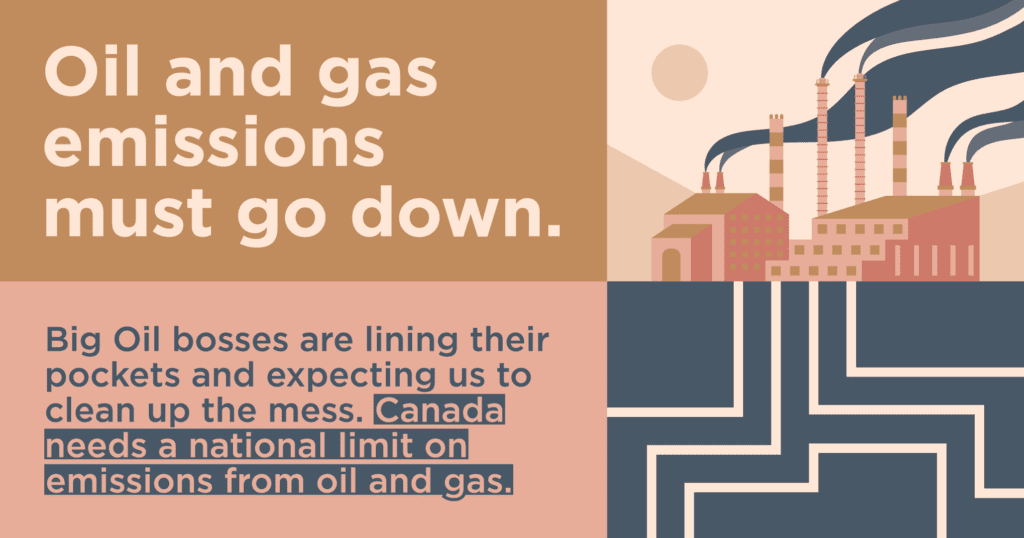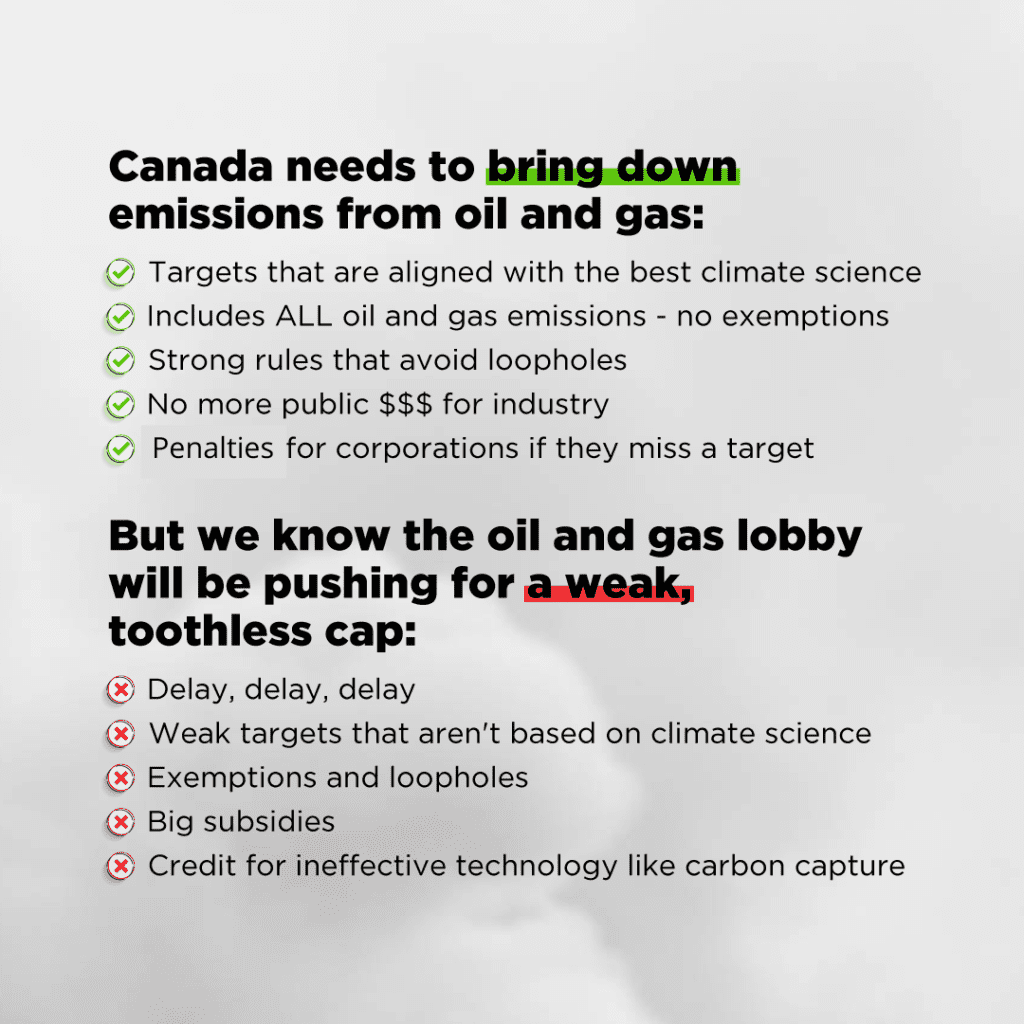
We are in the midst of a climate crisis – that much is certain. Gone are the days where the existence of human-caused climate change could be debated. Climate catastrophes are happening throughout our planet, and are only projected to get more intense and more frequent, unless we get a handle on addressing the leading cause of this crisis: Fossil Fuels.
Despite accounting for just 5 per cent of Canada’s economy, the oil and gas sector is the largest and fastest growing source of climate pollution, accounting for 27 per cent of Canada’s domestic greenhouse gas emissions. Emissions from the sector are rising; they have increased by nearly 20 per cent from 2005 levels.
Due to this unchecked increase in emissions from the oil and gas sector, combined with public pressure from environmental activists, in 2021 the Government of Canada finally committed to limit oil and gas emissions at a pace and scale needed to keep global average temperatures to below 1.5 degrees Celsius. What’s more, the Minister of Environment and Climate Change Steven Guilbeault even committed to have this policy in place by the end of 2023.
The Government of Canada’s credibility on climate change depends both on if this policy is ambitious and robust, and on whether the government is able to implement this policy within the next year. Canada can’t afford any more delays on this key policy, nor can we afford to have a weak approach if we are to reach global climate targets.
 What is the role of an emissions cap policy?
What is the role of an emissions cap policy?
It is evident that current policies regulating the oil and gas industry’s emissions are not up to the task, because the industry’s emissions have continued to rise. The oil and gas emissions cap policy, if implemented correctly, could be a key tool that is necessary to tackle Canada’s largest growing source of emissions.
A strong and equitable emissions cap policy can also be an important part of a strategy to help the Canadian economy transition from being over-reliant on fossil fuels towards a more competitive direction in the global context. It can also provide predictability to industry, workers, and communities, while providing opportunities for additional investments in climate solutions.
On the other hand, if this policy fails to hold the oil and gas industry accountable to reduce their own pollution at the levels that we need, this would place additional burden on other sectors, households and communities.
 How is the oil and gas industry attempting to weaken the emissions cap?
How is the oil and gas industry attempting to weaken the emissions cap?
What should be a sure fire way to finally get the largest source of pollution in Canada in check, is under threat of being watered down due to constant misinformation and lies from the fossil fuel industry. The oil and gas industry, backed by their vast resources and lobbying groups, are trying to convince the federal government and the people of Canada that immediate emissions reduction is not the right move – going against the scientific community and leading experts at the United Nations. They keep pushing for delay – never mind what it will cost people in Canada, and around the world, in terms of their lives and livelihoods. What’s more is that they want additional support (i.e. public tax dollars) to finance speculative, costly and hard to scale technologies like carbon capture, utilization and storage (CCUS).
It is well established that Canada, a wealthy and a high-emitting country, has benefited greatly through the extraction and production of oil and gas. This has lined the pockets of many oil and gas companies for decades. Even today, these companies are making record-breaking profits. However, this did not come without cost. Many Indigenous nations have been severely impacted due to the greed of oil and gas companies and the damage being done to the land, air and water. And of course it’s these companies who are driving the climate crisis – the vast majority of climate catastrophes are being faced by communities who didn’t benefit from fossil fuel extraction.
 What we need in an emissions cap
What we need in an emissions cap
With that in mind, the Government of Canada must ensure that the proposed oil and gas emissions cap policy takes into consideration the urgency of the climate crisis and compels the oil and gas industry to do their fair share to reduce emissions. The Government of Canada is considering two policy options for the emissions cap: a cap and trade model, and a modified carbon pricing model. The stronger of the two options, cap and trade, will set out a hard limit on the sector’s pollution, which will decline over time. Allowable emissions would be put up for auction for companies to purchase if they want to continue operating. However, for the policy to be successful, it must include the following principles:
- Fair share target: Put a hard cap on emissions from the oil and gas sector that aligns with the Paris Agreement of keeping global warming below 1.5°C. The emissions cap needs to reflect Canada’s responsibility to do its fair share of emissions reduction to keep global temperatures below 1.5°C, which would be an emissions reduction of 60 per cent from 2005 levels for the oil and gas sector, by 2030.
- No delays: It is of utmost importance that the oil and gas sector be made to meet the reductions target by 2030, regardless of what they claim is doable or not. The oil and gas industry has spent decades delaying and disputing climate action and this is just another version of their tired, old act. There are many ways readily available for the industry to meet a strong emissions cap, including reducing their methane emissions and electrifying their operations. The Intergovernmental Panel of Climate Change (IPCC) has clearly said to limit global temperatures to 1.5 degrees Celsius, we need to cut global emissions in half this decade. Canada has a big part to play in that.
- No offsets: The oil and gas sector must be held accountable for reducing their own emissions. They can not be let off the hook by using their vast amounts of money to purchase offsets for reductions elsewhere.
- No subsidies: Canadian environmental policy is founded on the Polluter Pays principle. It is reasonable to expect that the oil and gas companies, who have been raking in record-breaking profits, be made to pay to clean up their own mess without relying on taxpayer money , including for unproven technologies such as CCUS.
- Upholds Indigenous rights: The design and implementation of the oil and gas emission cap and related policy must uphold the inherent authority, title and rights of Indigenous peoples and other rights affirmed in the United Nations Declaration on the Rights of Indigenous Peoples (UNDRIP). This includes securing free, prior, and informed consent from each impacted Indigenous People for any and all new energy projects, regardless of the degree to which a project is already complete.
- Integrates equity into policy development: Taking care of people and their communities should be the first priority of the federal government when considering unintended consequences of climate action. Potential impacts related to implementation of the cap should be assessed and fully integrated into broader just transition planning, so that affected workers and communities can be fully supported. Proceeds from the auctioning of emissions credits under the cap and trade model should be used to support affected communities and workers, and communities who have been negatively impacted by the sector historically, specifically low-income, Indigenous and racialized communities.
A strong emissions cap is needed to meet Canada’s climate targets
Without a strong emissions cap policy that ensures that the oil and gas companies are doing their fair share, Canada has little chance of meeting its climate commitments. This was reaffirmed by the Net-Zero Advisory Body in their first annual report to Minister Guilbeault in January 2023. We can’t afford to let the oil and gas companies continue spewing their misinformation and falsehoods to once again try and delay climate action.
The Government of Canada has a responsibility to ensure that everyone in Canada has access to a climate safe-future, healthy environments and thriving communities – not to protect the profits of oil and gas companies. And a climate-safe future depends on Canada being able to limit and reduce the pollution from the oil and gas sector.
Tell Canada we need strong emissions cap to reduce oil and gas pollution.
The post We need to limit ever growing oil and gas emissions appeared first on Environmental Defence.
This post was originally published on Environmental Defence.